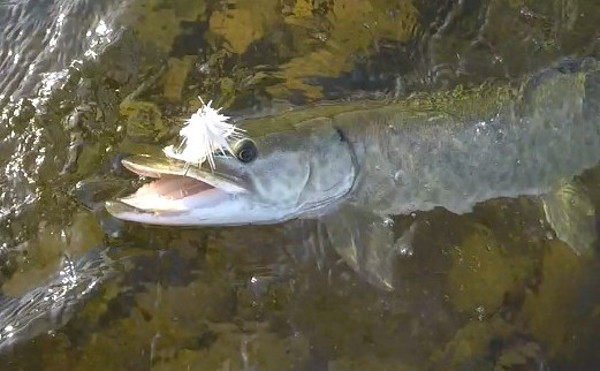
The most daunting part about targeting Pike and Musky on the fly (for beginners) is figuring out leaders. How do you set-up a leader for fly fishing Pike and Musky? You can’t very well just use the same tippet as you do when salmon angling, a pike will bite right through it!
It’s a question that stumped me when I first began fly fishing for esox species (Genus name for pike, musky, and pickerel). Especially since I was coming into the hobby as a long-time trout, salmon, and bass angler. As such, I had no experience working with wire leaders.
I spent far too much money looking for the right bite leader material. I’ve since found several solutions all with their advantages and disadvantages. I want to share what I’ve learned about different leaders for targeting esox species on the fly.
If you’re interested in learning more about fly fishing for pike and musky, see below:
Musky and Pike Fly Fishing Setup
Best Flies for Targeting Pike and Musky
This post uses Amazon affiliate links. I receive a commission from any sales at no additional cost to yourself.
Tie Your Own Leaders
I prefer to make my own leaders in most situations. There are two main types of bite tippet that I found to be good choices for making pike and musky leaders. Nylon-coated wire, and single-strand Nickel-Titanium wire (Knot 2 Kinky).
Nylon-coated Wire
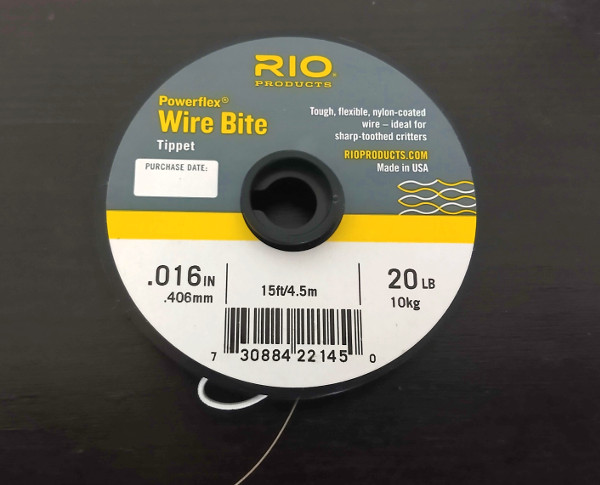
After trying many options on the market, I’ve settled on this as my preferred esox bite tippet. The Rio Wire Bite shown above is what I use for the majority of the pike and musky fishing I do.
Nylon coated wire ties much more easily than the other wire leaders available on the market. I use a double surgeon knot to connect the butt end of the wire to a length of either flouro or mono. Using an improved clinch knot to connect the wire directly to the fly works well.
The main advantage of this wire is that you don’t need to make your rigs before you hit the water. It’s easy enough to tie, that you can just swap out flies on the water as easily as if you were using mono tippet.
Another great advantage is that since it’s so easy to tie, there’s no need for snaps or swivels like with some other wire. This allows you to keep the entire rig as light as possible. Very important when you’re already chucking larger than normal flies targeting pike and musky.
My preferred brand of nylon wire is Rio’s Powerflex Wire Bite tippet. I usually run this in 20lb test, although I have various line strengths for different applications.
Rio Fly Fishing Tippet Powerflex Wire Bite Tippet (Amazon Link)
AFW makes a comparable wire tippet that I have used with success as well. Apparently Berkley does as well, although I have not had a chance to try their wire tippet out for myself.
A note on building fly fishing leaders. When building a leader, I recommend having a weak point somewhere no stronger than 25lb test in most situations. This is because breaking off a snag with stronger line ruins your fly line.
Breaking a strong leader ruins your fly line in two ways. The first is that it overstretches the fly line. This will shorten it’s life and may reduce how well it casts. It also ruins the line if you are using a perfection loop. The loop to loop connection digs into the coating on the fly line when trying to break off a strong leader.
You can make breaking off your leader easier by doing one of the following:
- Incorporating a 6″ stretch of weaker line mid-way through the leader or,
- Ensuring that the end of the leader itself is no stronger than 25 lb line strength.
I tend to go for the latter, and typically run 20lb Rio wire as my bite tippet unless I know a trophy fish is likely and risk of snags is minimal.
My typical pike leader is: Loop to loop connection(perfection loop) from fly line to 3 feet of 25 pound test flouro. This is followed by a 1 to 2 foot length of 20 pound test Rio Wire Bite. I usually tie on 2 feet of the wire to start, and swap it out once it gets down to a foot after a few fly changes. I sometimes size up for musky, but lately, have not found it to be necessary.
There’s generally no need for tapered leaders, as the fly line will be doing most of the work of turning the large flies over. If you’re not yet aware, casting these large flies can be quite the workout.
Knot 2 Kinky Wire
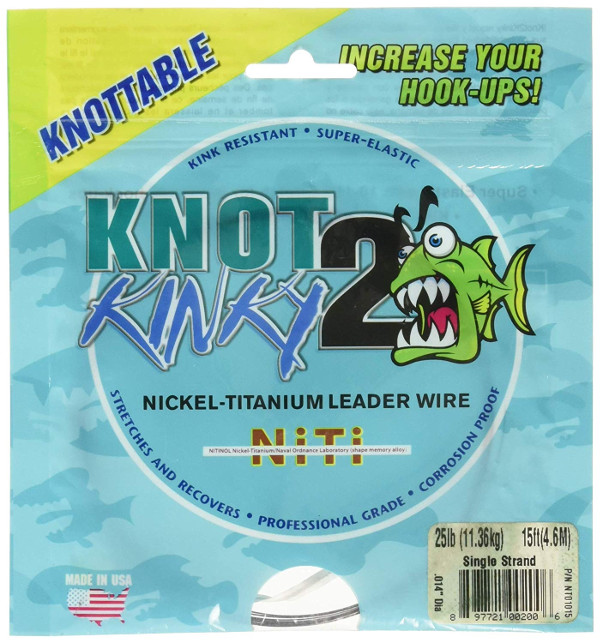
Even though I prefer the nylon coated wire mentioned above, there are other viable alternatives on the market. Knot 2 Kinky is one of the better alternatives and is the go-to choice for many esox anglers (both spinning and fly anglers).
My favourite feature of this wire is that it actually stretches and recoils by 10%. This is in contrast to many other leaders that either have a one-time initial stretch or not stretch at all. This built-in stretch helps absorb the force from the savage stikes common when pike or musky fishing. The stretch reduces the risk of a break off from the initial strike.
Once rigged, a Knot 2 Kinky leader is one of the better options on the market for esox fishing. The key part of that sentence being “once rigged”. I find the wire harder to work with than some other leaders, such as the nylon coated wire mentioned above.
Rigging all your leaders prior to a fishing trip becomes a necessity when using Knot 2 Kinky wire. Otherwise, you’ll be fighting with it out on the water. I found using pliers to cinch the knots down helps alot when working with Knot 2 Kinky.
A solid leader setup for large musky and pike is 4 feet of 40pound test of flouro, tied to 2.5 feet of 25 pound test of flouro with a double uni knot, which is then tied to 1 to 2 feet of 35 pound Knot2Kinky, followed by a size 1 Mustad fastach swivel clip. If you’re worried about weight, you can use a fastach clip without the swivel.
Knot2Kinky Wire 25-Pound (Amazon Link)
This setup was recommended to me when I first started fishing for musky. It gets around the break off the issue mentioned earlier by having a 80cm stretch of 25 pound test line. While still on the difficult side to break off, atleast you won’t ruin most higher quality fly lines running this rig.
I have had success using the above leader when I first started esox fly fishing. I’ve just come to prefer using the Rio wire mentioned earlier.
Swivel Clips
Long-time fly anglers may balk at this, but I recommend always using a Mustad fastach swivel clip with Knot 2 Kinky Wire. Tying a Knot 2 Kinky leader directly to the fly isn’t feasible both due to difficulty in tying knots and how fast you will go through leader material.
You may actually consider using these clips at the end of any wire leader if saving material is a concern to you. The size of the flies used generally means the extra weight from the clip is manageable, even if not ideal. The flies are also large enough that the clip isn’t immediately obvious in the water compared to the fly.
Fastach clips are fantastic in that they are quite strong for how small and light they are, perfect for fly fishing. They are also very easy to use.
Mustad Fastach Clip Size 1-without swivel (Amazon Link)
Pre-Rigged Fly Fishing Leaders
If you don’t want to bother making your own leaders, you can buy a pre-rigged leader. This option is my recommendation for the angler that doesn’t intend on switching flies that often.
I’m going to sound like a RIO fanboy (I’m really not, they just make the best products on the market in this instance), but the RIO Pike/Musky tapered leader is the best one I’ve found on the market.
I have to assume the wire is the same as their Powerflex wire bite tippet, although I don’t know this for sure. In any case, the wire on this leader ties extremely nicely. It’s the closest to tying with mono of any wire leader I’ve tried.
RIO Leader Pike/Musky 20Lb Knottable Wire (Amazon Link)
An unfortunatley drawback of using a pre-rigged leader with knottable wire is that you only get so much wire to work with. After swapping out half a dozen flies, it’s time to switch out the entire leader as it’s now too short to be useful.
Keeping the above point in mind, you don’t change flies nearly as often fishing for pike and musky as you do for many other species. Presentation and location are much more important to success when esox fishing than pattern selection (although fly selection shouldn’t be discounted entirely).
If you are the type that swaps flies often, I recommend buying the version with a snap link. The snap link is quite small and light, so adds very little extra weight.
This is also a good option if you’re going for numbers rather than size. Esox teeth tend to tear up flies after a few fish. It might be a good time to take up tying your own flies as well if you haven’t done so already.
RIO Leader Pike/Musky 15Lb with Snap (Amazon Link)
RIO Toothy Critter leader is a comparable product to the link above.
Scientific angler also makes a range of Esox specific pre-tied leaders that perform very well. The Esox special pictured above is one of the options available from Scientific Angler.
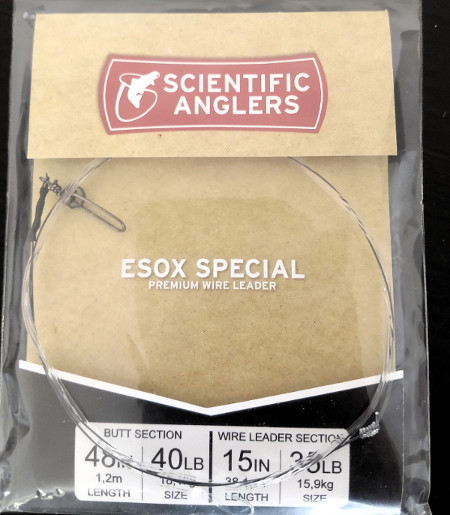
The leader linked below is the aptly named figure 8 wire leader. Named after the common musky technique of figure-8-ing a lure or fly boat side at the end of every retrieve. It’s specifically tailered to suit musky fly fishing from a boat.
Scientific Anglers Figure 8 Wire Leader (Amazon Link)
Spin Fishing Wire Leaders
Using pre-rigged wire leaders intended for spin fishing is another option. While I have used them with success when I first started targeting toothy critters, I now find them typically too heavy. They also don’t cast as well as some of the other options on this list.
You can lighten them up a bit by using wire cutters to remove the swivel on one end and just leaving the clip on the other. You can then connect to the remaining loop using a loop-to-loop connection. Use a perfection loop on your mono or flouro to connect to the wire in this case.
Bite Resistant Leaders for Fishing other Species.
What if you’re not targeting pike, but there’s lots of pike in the water your fishing? Bass bite rates drop dramatically when using wire leaders. Forget about ever catching a trout using a wire leader.
The solution is to use flourocarbon leaders. Flourocarbon leaders are used all the time targeting pike and musky in heavy 50lb+ strength line. When targeting bass in pike infested waters though, 50lb+ test is a bit overkill.
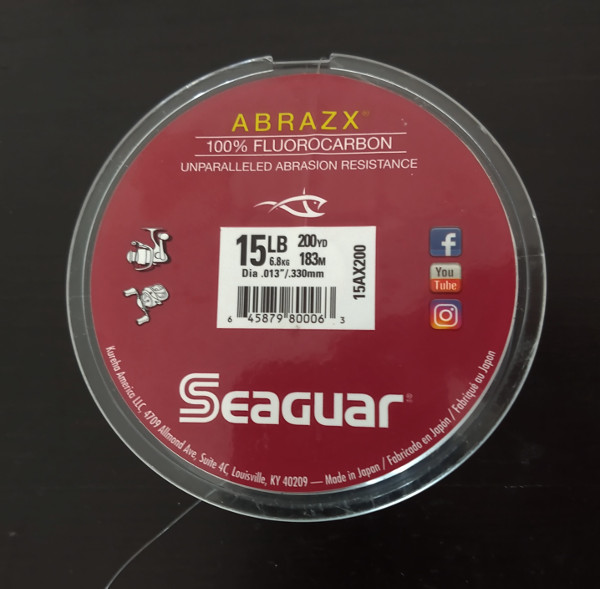
Instead, I use a lower strength line. Specifically, the 15lb test Seaguar Abrazx pictured above. 15lb isn’t enough to protect against all bite offs, but I have landed quite a few incidental dink pike one this leader while bass fishing. Without this leader, I likely would have lost most of those flies.
Not all flourocarbon lines are created equal. Some focus on transparency, some on line strength, and other on abrasion (aka teeth & rocks) resistance. Is the abrasion-resistant flourocarbon that you want for fishing with the risk of incidental pike.
I want to emphasize that you shouldn’t target pike or musky with the above line. Bite offs are still likely, just reduced when compared to other flourocarbon or mono leader options.
This brings me to flourocarbon bite leaders intended specifically for targeting toothy critters.
Flourocarbon Bite Leaders
In the interest of being thorough, I should mention flourocarbon bite leaders. While they have their place in spin fishing, I don’t think they’re a good fit for fly fishing, and here’s why.
Flouro used as a bite leader in spin fishing is often 50+lb strength line, sometimes as high as 120lb strength. This is far to heavy to cast well using a fly line. These strength lines also require crimps rather than being tied, adding more weight.
You could try lighter line in the 30lb to 40lb range. Be sure to use a stretch of weaker line somewhere in the leader. You don’t want to ruin your fly line if you need to break off.
It should be mentioned that hardened mono is another solution. I’ve heard from other anglers that they have had success with hardened mono. Honestly I have no experience with this at all, so am unable to speak to it further. Just be aware the option exists.
Even though flouro offers the advantage of being less visible, I find wire leaders work well for me with zero risk of bite off.
Conclusion
In conclusion, I recommend either of the following for most esox fly anglers.
- Rio Wire Bite Tippet or
- One of the pre-tied leaders from RIO or Scientific Anglers.
If you’re experienced at making your own leaders, Knot 2 Kinky may be worth trying out due to it’s stretch and resistance to kinks.
I hope the information above has helped you find a solution for what wire to use when fly fishing for pike and musky.
Interested in some of the most effective Pike and Musky flies? Click here.

8 thoughts on “Pike and Musky Fly Fishing Leaders”